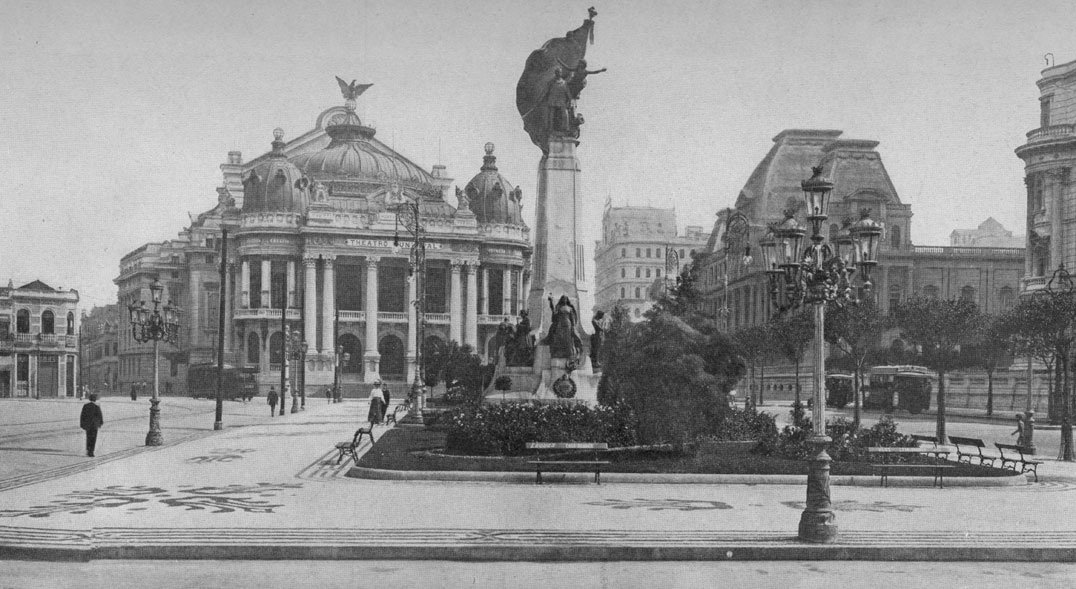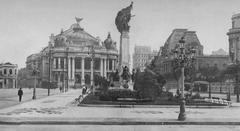
Theatro Municipal Rio de Janeiro: Visiting Hours, Tickets, and Historical Significance
Date: 14/06/2025
Introduction
The Theatro Municipal do Rio de Janeiro is a crown jewel of Brazil’s cultural and architectural heritage, rising majestically in the heart of Cinelândia Square. Since its inauguration in 1909, it has been a beacon for the arts, blending European elegance with Brazilian creativity. Today, the theater is not only a stage for world-class performances but also an essential stop for visitors eager to experience Rio de Janeiro’s rich artistic and historical legacy. This comprehensive guide details its origins, architectural marvels, cultural impact, visiting hours, ticketing, accessibility, and practical travel tips.
Table of Contents
- Introduction
- Origins and Historical Context
- Architectural Design and Construction
- Inauguration and Early Years
- Expansion and Modernization
- Restoration and Preservation
- Visiting Information
- Architectural Inspiration and Design Origins
- Exterior Features
- Structural Innovations
- Interior Grandeur
- Renovations and Preservation
- Visitor Information Summary
- Historical Background
- Cultural Significance
- Theatro Municipal Visiting Hours and Guided Tours
- Performance Attendance and Theatro Municipal Tickets
- Visitor Tips
- Getting There: Location and Transport
- Nearby Historical Sites and Attractions
- Practical Information
- Frequently Asked Questions (FAQ)
- Conclusion
- References
Origins and Historical Context
The Theatro Municipal was conceived during a pivotal period of early 20th-century urban reform in Rio de Janeiro, as Brazil’s capital sought to mirror the sophistication of European metropolises. The city’s transformation, spearheaded by Mayor Francisco Pereira Passos, introduced grand boulevards and monumental architecture, with the Theatro Municipal envisioned as the cultural centerpiece of these reforms (Wikipedia; Live the World).
A public competition in 1903 resulted in the selection of a design that married the Beaux-Arts vision of French architect Albert Guilbert with the practical expertise of Brazilian engineer Francisco de Oliveira Passos (Google Arts & Culture). Construction began in 1905 and culminated in a grand opening on July 14, 1909.
Architectural Design and Construction
The Theatro Municipal’s design is a testament to cosmopolitan ambition, inspired by the grandeur of Paris’s Palais Garnier. Its imposing facade of white marble and granite is adorned with gilded details, while its bronze-and-glass dome, crowned with a bronze eagle, dominates Cinelândia Square (Triphobo). The building rests on over 1,000 hardwood stakes driven into Rio’s marshy soil—a feat of engineering for its time (Free Walker Tours).
Inside, the theater dazzles with marble staircases, gilded mirrors, stained glass mosaics, and murals by celebrated Brazilian artists such as Eliseu Visconti, Rodolfo Amoedo, and the Bernardelli brothers (Time Out). The main auditorium, horseshoe-shaped for ideal acoustics, seats over 2,200 guests and is crowned by Visconti’s masterpiece ceiling fresco, “The Dance of the Hours.”
Inauguration and Early Years
The theater’s inauguration was a national event, with an inaugural program featuring Brazilian composers and an audience that included the country’s most prominent political and social figures (Google Arts & Culture). In its early decades, the theater primarily hosted international opera and ballet companies, establishing Rio as a cultural capital.
Expansion and Modernization
In response to growing demand, the theater underwent expansions in 1934 and later years, increasing its capacity and updating its technical facilities (Wikipedia). The establishment of resident artistic bodies in the 1930s—including a symphony orchestra, choir, and ballet—was a unique achievement among Brazilian cultural institutions (Casa e Jardim).
Restoration and Preservation
The Theatro Municipal has been meticulously preserved and periodically restored, with major renovations in 1934, 1975, 1996, and a centennial restoration from 2008–2010 that revitalized its facades, interiors, and technical infrastructure (Free Walker Tours). In 2025, a major stage revitalization project is set to introduce advanced flooring and stage systems, ensuring the theater remains at the forefront of performance technology (Casa e Jardim).
Visiting Information
Opening Hours
- Performances: Typically from Tuesday to Sunday, with showtimes varying by event.
- Guided Tours: Tuesday to Friday at 12:00, 14:00, 15:00, and 16:00; Saturday at 11:00, 12:00, and 13:00 (imaginariodejaneiro.com).
- Box Office: Opens 30 minutes before each guided tour.
Tickets and Pricing
- Guided Tours: R$20 general, R$10 for students and seniors, free for children under 5. Tickets are sold at the box office before each tour; advance purchase is not available.
- Performances: Tickets can be purchased online or at the box office. Prices vary by event and seat; discounts for students, seniors, and children are available (riotur.rio).
Accessibility
The theater is fully accessible, with wheelchair ramps, elevators, and assistive listening devices. Visitors with specific needs should contact the theater in advance to arrange appropriate accommodations.
Guided Tours
Tours are available in Portuguese, English, and Spanish, lasting about 45 minutes. They cover the main auditorium, grand staircase, royal box, and backstage areas, offering rich insight into the theater’s architecture and history (imaginariodejaneiro.com).
Special Events and Performances
The Theatro Municipal hosts a diverse calendar of opera, ballet, symphonic concerts, and occasional popular music performances. Consult the official program for current schedules and ticketing.
Travel Tips
- Dress Code: Smart casual for tours; formal or smart casual for performances.
- Photography: Allowed during tours without flash or tripods; prohibited during performances.
- Arrive Early: For both tours and performances, early arrival ensures the best experience.
- Language: Specify tour language preference at ticket purchase.
- Safety: The area is safe during the day but remain aware of your surroundings and avoid displaying valuables.
Architectural Inspiration and Design Origins
Inspired by French Beaux-Arts principles, the theater’s design was selected through a national competition and reflects the city’s aspirations for cultural parity with European capitals. Its harmonious blend of neoclassical and art nouveau elements sets it apart as one of the most beautiful theaters worldwide (Triphobo).
Facade and Materials
The facade features white marble, granite, gilded accents, and grand Corinthian columns. Above the entrance, allegorical statues symbolize music, poetry, and dance (Rio de Janeiro.com). The dome’s green and gold tiles are topped with a bronze eagle—an emblem of artistic aspiration.
Sculptural Elements
The building is adorned with sculptures and reliefs by the Bernardelli brothers and Rodolfo Amoedo, communicating its dedication to the arts (Triphobo).
Lighting and Nighttime Ambience
At night, an advanced lighting system highlights the building’s architectural features, creating a dramatic focal point in Cinelândia.
Structural Innovations
Foundation and Engineering
1,180 hardwood piles anchor the theater, ensuring stability on Rio’s soft ground (Free Walker Tours).
Capacity and Acoustics
The horseshoe-shaped auditorium, seating over 2,250 people, is renowned for its acoustics, rivaling leading opera houses (FeverUp).
Interior Grandeur
Main Auditorium
Visitors are greeted by a grand foyer with marble columns and gilded detailing. The auditorium’s plush red seats, ornate balconies, and Visconti’s ceiling fresco create a breathtaking visual spectacle (Triphobo).
Artistic Highlights
- Eliseu Visconti: Ceiling fresco and drop curtain.
- Rodolfo Amoedo & Bernardelli brothers: Sculptures and paintings throughout.
The Assírius Restaurant
In the basement, the Assírius Restaurant’s Assyrian-style decor offers guests a unique architectural experience (Triphobo).
Renovations and Preservation
Major restorations have preserved the theater’s splendor and modernized its technical infrastructure (notably in 1934, 1975, 1996, and 2008–2010), ensuring it remains a living museum and world-class performance venue (Free Walker Tours; Casa e Jardim).
Visitor Information Summary
- Operating Hours: Guided tours Tuesday–Saturday; performances Tuesday–Sunday.
- Ticketing: Box office and online for performances; box office only for tours.
- Accessibility: Fully accessible; contact ahead for specific needs.
- Languages: Tours in Portuguese, English, and Spanish.
- Nearby Attractions: National Library, Museu Nacional de Belas Artes, Confeitaria Colombo, Arcos da Lapa, among others (imaginariodejaneiro.com).
Historical Background
The Theatro Municipal’s conception was heavily influenced by Brazil’s cultural leaders who sought a venue worthy of the nation’s artistic aspirations. Its construction and subsequent expansions reflected the growth of Rio as a cosmopolitan hub (cultura.rj.gov.br; riotur.rio).
Cultural Significance
Hosting a resident orchestra, choir, and ballet company, the theater is unique in Brazil and has welcomed legendary international and Brazilian artists throughout its history. Its influence extends nationally and internationally, making it a benchmark for Latin American cultural institutions (imaginariodejaneiro.com; thingstodoeverywhere.com).
Theatro Municipal Visiting Hours and Guided Tours
- Guided Tours:
- Tuesday to Friday: 12:00, 14:00, 15:00, 16:00
- Saturday: 11:00, 12:00, 13:00
- Tickets: R$20 (general), R$10 (students/seniors), Free (children under 5)
- Tickets sold at the box office 30 minutes before each tour; limited spots per group (imaginariodejaneiro.com; riotur.rio).
Performance Attendance and Tickets
To attend a live performance, purchase tickets via the official website or at the box office. Prices and schedules vary by event.
Visitor Tips
- Dress appropriately for performances (smart casual or formal).
- Photography permitted during tours (no flash/tripods); not allowed during shows.
- Arrive early to secure your spot for tours and performances.
- Specify your preferred language when buying tour tickets.
- Consider combining your visit with nearby historic sites and museums.
Getting There: Location and Transport
- Metro: Cinelândia Station (Lines 1 and 2) is a short walk.
- Bus: Multiple city lines serve the area.
- Taxi/Ride-share: Widely available.
- Parking: Limited; public transport is recommended (imaginariodejaneiro.com).
Nearby Historical Sites and Attractions
- National Library
- Museu Nacional de Belas Artes
- Confeitaria Colombo
- Arcos da Lapa
- Largo do Machado Park
- Selarón Steps
- The area is rich in cultural venues, historic cafes, and architectural gems (freewalkertours.com).
Practical Information
- Check the official website for current visiting hours and event schedules.
- Safety: The area is generally safe during the day; use standard precautions.
- Café: On-site café available for refreshments.
For deeper insight into Rio’s architectural and urban history, consider joining a specialized walking tour (ga-riodejaneiro.com).
Frequently Asked Questions (FAQ)
Q: What are the Theatro Municipal visiting hours for guided tours?
A: Tuesday–Friday: 12:00, 14:00, 15:00, 16:00; Saturday: 11:00, 12:00, 13:00.
Q: How can I purchase Theatro Municipal tickets?
A: Performance tickets are available online and at the box office; tour tickets are sold at the box office before each tour.
Q: Is the theater accessible for visitors with disabilities?
A: Yes, the theater is fully accessible; contact ahead for special requirements.
Q: Are tours offered in languages other than Portuguese?
A: Yes, English and Spanish tours are available.
Q: Are there nearby historical attractions?
A: Yes, including the National Library, Museu Nacional de Belas Artes, and Selarón Steps.
Conclusion
The Theatro Municipal do Rio de Janeiro stands as an enduring symbol of Brazil’s cultural ambition and artistic excellence. Its architectural grandeur, storied history, and ongoing commitment to the arts make it a must-visit for anyone exploring Rio de Janeiro’s cultural landscape. Take a guided tour, attend a live performance, and immerse yourself in the living artistry of one of Latin America’s most dazzling theaters.
Stay Connected and Explore More
- Download the Audiala app for audio guides and insider tips on Rio’s top attractions.
- Follow us on Facebook, Instagram, and Twitter for the latest updates.
References
- Wikipedia
- Live the World
- Google Arts & Culture
- Casa e Jardim
- Rio Memórias
- Triphobo
- Time Out
- Free Walker Tours
- imaginariodejaneiro.com
- cultura.rj.gov.br
- riotur.rio
- thingstodoeverywhere.com
- FeverUp
- ga-riodejaneiro.com
- Audiala app




















































